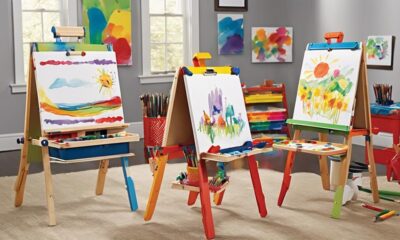Carnival Decoration
Is Carnival Glass Worth Anything?
2025

When it comes to Carnival Glass, it’s like looking through a captivating kaleidoscope of history and artistry.
But the question lingers: is it worth anything? As collectors and enthusiasts, we've all pondered this at some point.
The answer isn't as straightforward as one might hope. Join us as we unravel the intricacies of Carnival Glass valuation and explore the factors that influence its worth.
Key Takeaways
- Carnival glass was created as a low-cost alternative to expensive art glass in the early 1900s.
- The value of carnival glass is influenced by factors such as rarity, demand, condition, and authenticity.
- Certain colors and intricate patterns are more desirable among collectors and can impact the value.
- Understanding market trends, collector preferences, and accurate assessment of rarity and demand is crucial for valuation.
History of Carnival Glass
Carnival glass was first produced in the early 1900s and quickly gained popularity for its vibrant colors and iridescent sheen. The history of manufacturing carnival glass dates back to the early 1900s when it was initially created as a low-cost alternative to the more expensive art glass produced by companies like Tiffany and Steuben. Manufacturers used a technique called 'marigold' to produce a spectrum of colors, including purple, blue, green, and amber, which contributed to the glass's popularity. The iridescent effect was achieved by spraying the hot glass with metallic salts, giving it a shimmering, rainbow-like appearance.
Popular designs of carnival glass include the 'Peacock Tail,' 'Raspberry,' 'Three Fruits,' and 'Orange Tree,' each known for its intricate patterns and vibrant hues. Collectors often seek out these designs due to their historical significance and aesthetic appeal.
The manufacturing history of carnival glass is a fascinating journey that reflects the innovation and creativity of early 20th-century glassmakers.
Identifying Carnival Glass Patterns

The historical significance and aesthetic appeal of carnival glass designs such as 'Peacock Tail,' 'Raspberry,' 'Three Fruits,' and 'Orange Tree' make identifying their intricate patterns an engaging pursuit for collectors and enthusiasts of early 20th-century glassmaking.
When identifying carnival glass patterns, it's essential to familiarize oneself with the various identifying techniques. One effective method is to examine the surface closely under proper lighting to discern the iridescence and pattern details. Collectors should also study reference materials and online resources to gain expertise in recognizing the distinguishing features of different patterns. Understanding the manufacturing processes and mold variations can also aid in pattern identification.
Additionally, seeking guidance from experienced collectors and attending glassware exhibitions and auctions can provide valuable insights and exposure to a wide array of carnival glass patterns. When collecting carnival glass, it's advisable to carefully document and photograph the patterns for reference. Furthermore, staying updated on the current market trends and prices can assist collectors in making informed decisions when acquiring carnival glass pieces.
Factors Affecting Carnival Glass Value
Understanding the various factors that influence the value of carnival glass pieces is essential for collectors and enthusiasts seeking to navigate the intricate world of glassware valuation. When determining the worth of carnival glass, several key factors come into play, including the rarity of the piece, its condition, the color and pattern, and current market trends.
| Factors Affecting Carnival Glass Value | Description |
|---|---|
| Rarity | The scarcity of a particular carnival glass pattern or shape significantly impacts its value. Rarer pieces command higher prices due to their limited availability. |
| Condition | The condition of the glass, including the presence of chips, cracks, or repairs, plays a crucial role in determining its value. Pristine pieces are more sought after and, consequently, more valuable. |
| Color and Pattern | Certain colors and intricate patterns are more desirable among collectors, leading to higher market value for these specific variations. |
| Market Trends | Fluctuations in the market, influenced by collector demand and auction results, can impact the value of carnival glass over time. Staying informed about current market trends is vital for understanding the potential worth of carnival glass pieces. |
| Provenance | The history and documented provenance of a carnival glass piece can add significant value, especially if it has a noteworthy or prestigious background. |
These factors, along with market trends, collectively contribute to the ever-changing value of carnival glass, making it imperative for enthusiasts to stay informed and knowledgeable in order to make informed decisions about their collection.
Pricing and Valuation of Carnival Glass

When it comes to pricing and valuing carnival glass, there are several key factors to consider.
Market value is influenced by factors such as the rarity of the piece and the current demand for it.
Additionally, the condition and authenticity play a crucial role in determining the worth of carnival glass items.
Market Value Factors
Determining the market value of carnival glass involves considering various factors, including the color, pattern, condition, and rarity of the pieces. When appraising carnival glass, collectors and investors should take into account the following:
- Color: Certain hues such as amethyst, cobalt blue, and red are highly sought after, impacting the value of the glassware.
- Pattern: Intricate and unusual patterns contribute to the desirability and market value of carnival glass.
- Rarity: Pieces that are rare or limited in production tend to command higher prices due to their scarcity in the market.
Understanding these factors is crucial for accurately assessing the market trends and investment potential of carnival glass. Incorporating appropriate appraisal methods enables collectors to make informed decisions regarding the value and potential of their carnival glass collection.
Rarity and Demand
Considering the rarity and demand of carnival glass is essential for accurately determining its pricing and valuation in the market.
Rarity plays a crucial role in establishing the value of carnival glass. Limited production runs, discontinued patterns, and unique color variations contribute to its scarcity, making certain pieces highly sought after by collectors. The rarity of specific items can significantly impact their investment potential, driving up their market value.
Furthermore, the demand for carnival glass is influenced by factors such as design intricacy, historical significance, and overall aesthetic appeal. Pieces that are in high demand due to their rarity and desirability often command higher prices in the marketplace.
Understanding the interplay between rarity and demand is fundamental for assessing the investment potential of carnival glass and accurately valuing these exquisite collectibles.
Condition and Authenticity
The rarity and demand of carnival glass are key factors influencing its valuation and pricing. As we pivot to the subtopic of 'Condition and Authenticity' (Pricing and Valuation of Carnival Glass), it becomes crucial to thoroughly assess the integrity and originality of each piece to determine its market worth.
- Authenticity Verification:
- Careful examination of the glass to confirm it's indeed carnival glass and not a reproduction.
- Researching the manufacturer's markings and patterns to authenticate its origin.
- Consulting experts or reference materials to validate the piece's authenticity.
Condition Assessment:
- Inspecting for chips, cracks, or repairs that can significantly impact value.
- Evaluating the iridescence and color to ensure they're consistent and not altered.
- Considering the overall condition of the piece, including any wear or damage that may affect its desirability and price.
Rarity and Collectibility of Carnival Glass

When it comes to Carnival Glass, the rarity of certain pieces can greatly impact their value and collectibility. Understanding which patterns or colors are harder to find can guide collectors in their search for valuable pieces.
Additionally, the historical significance and popularity of certain Carnival Glass designs can further enhance their collectibility.
Rarity of Carnival Glass
With its myriad of colors, intricate patterns, and iridescence, carnival glass has captivated collectors and enthusiasts alike, making its rarity a key factor in its collectibility and value.
The rarity of carnival glass significantly impacts its valuation in the market. This unique glassware is sought after due to its scarcity, which drives up its market demand and ultimately its worth.
Factors contributing to the rarity of carnival glass include:
- Limited Production: Many carnival glass pieces were produced in limited quantities, making certain patterns or colors particularly rare.
- Discontinued Lines: Some carnival glass patterns were discontinued shortly after production, further adding to their rarity.
- Unique Variations: Certain variations or experimental pieces were never mass-produced, contributing to their exceptional rarity.
Understanding the rarity of carnival glass is crucial in assessing its value and desirability in the collector's market.
Collectibility of Carnival Glass
Evaluating the rarity and collectibility of carnival glass involves considering various factors that contribute to its market demand and value.
The carnival glass market is influenced by the availability of specific patterns and shapes, as well as the condition of the glassware. Collectors often seek out pieces with intricate designs, vibrant colors, and iridescence, which can significantly impact their desirability and worth.
Additionally, the historical significance of carnival glass, particularly in relation to specific manufacturers or time periods, can affect its collectibility.
When it comes to collecting tips, it's essential to research and familiarize oneself with the different patterns, makers, and identifying marks to make informed purchasing decisions.
Understanding the nuances of carnival glass can enhance the overall experience of building a valuable and rewarding collection.
Tips for Buying and Selling Carnival Glass

When assessing Carnival glass for potential purchase or sale, it's essential to carefully examine the iridescence, pattern, and overall condition of the piece to ensure its value and authenticity.
When considering buying or selling Carnival glass, there are several important factors to keep in mind:
- Iridescence: Look for rich, vibrant colors with a noticeable shimmer. High-quality iridescence can significantly increase the value of the piece.
- Pattern: Pay attention to the intricacy and uniqueness of the pattern. Rarer patterns often command higher prices in the market.
- Condition: Thoroughly inspect the glass for any chips, cracks, or scratches. Mint condition pieces are more desirable and valuable to collectors.
When selling Carnival glass, it's important to highlight the unique features and historical significance of the piece to potential buyers. Emphasizing the rarity of certain patterns or the craftsmanship of the glass can help maximize its value.
On the other hand, when buying Carnival glass, consider seeking out reputable sellers and auctions to ensure the authenticity and value of the piece. Understanding these key factors will empower both buyers and sellers in the Carnival glass market.
Preserving and Caring for Carnival Glass

To preserve and care for Carnival glass, it's crucial to handle the pieces delicately, avoiding harsh cleaning agents and abrasive materials that could damage the delicate iridescent surfaces. When cleaning, use mild dish soap and warm water, gently wiping the glass with a soft cloth or sponge. Avoid harsh scrubbing, as it can remove the iridescence.
To prevent scratches, it's advisable to line the sink with a towel or soft mat before washing the glass. For stubborn dirt or grime, a mixture of vinegar and water can be used, followed by a gentle rinse and thorough drying with a soft, lint-free cloth.
Proper preservation techniques also include storing Carnival glass pieces in a secure and stable environment. Avoid exposing them to direct sunlight, extreme temperatures, or high humidity. Display options can vary from using glass cabinets with adjustable shelves to prevent overcrowding and potential damage, to individual glass stands or wall-mounted display cases. These methods not only help preserve the glass but also showcase its iridescence and intricate patterns.
Frequently Asked Questions
Can I Use Carnival Glass for Everyday Use, or Is It Just for Display?
We use carnival glass for everyday use and have found it to be durable. However, it's also a great choice for display, with its beautiful iridescence.
When using it daily, we've found that gentle hand washing with mild dish soap maintains its luster. Despite misconceptions, carnival glass isn't fragile and can be enjoyed regularly.
Many collectors showcase it at events and auctions, and it offers creative display ideas for any home.
Are There Any Specific Techniques for Cleaning and Maintaining Carnival Glass?
When it comes to cleaning and maintaining carnival glass, there are specific techniques and preservation methods to keep in mind.
Gentle hand washing with mild dish soap and warm water is ideal. Avoid harsh chemicals and abrasive scrubbers to prevent damaging the iridescence.
Additionally, storing the glass away from direct sunlight and extreme temperatures can help preserve its beauty.
Regular dusting and occasional polishing with a soft cloth can also maintain its lustrous appearance.
What Are Some Common Misconceptions About Carnival Glass That Collectors Should Be Aware Of?
Misconceptions about carnival glass are plentiful, and collectors should be aware of them.
One common myth is that all carnival glass is iridescent, when in fact, some pieces are not.
Another misconception is that all carnival glass is valuable, which isn't true, as value depends on factors like rarity and condition.
When it comes to collecting tips, researching patterns and colors can help collectors identify valuable pieces.
Are There Any Specific Events or Auctions Where I Can Find a Good Selection of Carnival Glass for Sale?
We've found that the carnival glass market offers a variety of events and auctions perfect for collectors. These venues are excellent for finding a wide selection of carnival glass for sale.
As collectors ourselves, we've had success at specialized antique shows, online auctions, and dedicated carnival glass events.
Our collecting tips include researching reputable events and auctions, networking with other collectors, and staying informed about current market trends.
What Are Some Creative Ways to Display Carnival Glass in My Home?
When it comes to creating captivating displays of vintage charm, creative arrangements are key.
Incorporating carnival glass into home decor offers a unique styling opportunity. Consider using glass vases and bowls to showcase vibrant flower arrangements, or group pieces on a mantel for a stunning visual impact.
Experiment with different lighting to highlight the iridescence. These creative approaches elevate the aesthetic appeal of carnival glass in any home setting.
Conclusion
So, is carnival glass worth anything?
The answer is yes, and no. While some pieces can fetch a hefty sum due to their rarity and desirability, others may not be worth much at all. It all depends on the specific piece, its condition, and the current market demand.
So, next time you come across a piece of carnival glass, remember that it may be a hidden treasure or just a colorful trinket.
Happy hunting!
- About the Author
- Latest Posts
Introducing Ron, the home decor aficionado at ByRetreat, whose passion for creating beautiful and inviting spaces is at the heart of his work. With his deep knowledge of home decor and his innate sense of style, Ron brings a wealth of expertise and a keen eye for detail to the ByRetreat team.
Ron’s love for home decor goes beyond aesthetics; he understands that our surroundings play a significant role in our overall well-being and productivity. With this in mind, Ron is dedicated to transforming remote workspaces into havens of comfort, functionality, and beauty.
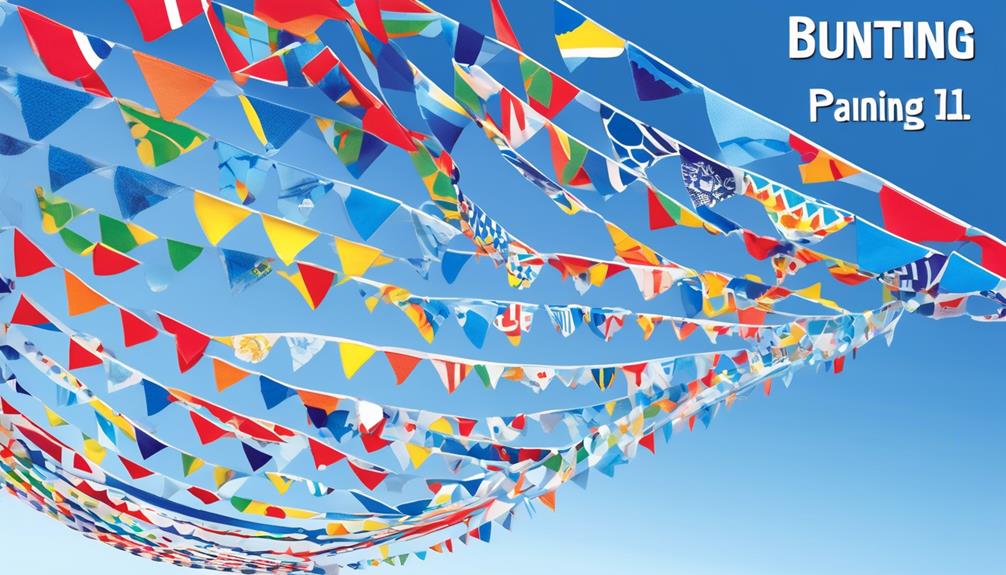
Have you ever thought about why bunting is named bunting?
It's like peeling back the layers of a mysterious package, each layer revealing a little more about its origins and cultural significance. The evolution of its name is a fascinating journey that takes us through different languages and historical contexts.
But there's more to it than just etymology; bunting holds a unique place in various cultures and has a modern appeal that continues to captivate.
So, let's unravel the mystery and discover the intriguing story behind why bunting is called bunting.
Key Takeaways
- The word 'bunting' originated from the Old French word 'bontin' and was initially used for maritime flag communication.
- Over time, 'bunting' evolved into festive decorations for land-based celebrations.
- Bunting is deeply ingrained in traditional celebrations worldwide and symbolizes unity, patriotism, and celebration.
- Bunting is a versatile decorative element that adds nostalgia and whimsy to events and settings.
Origins of Bunting
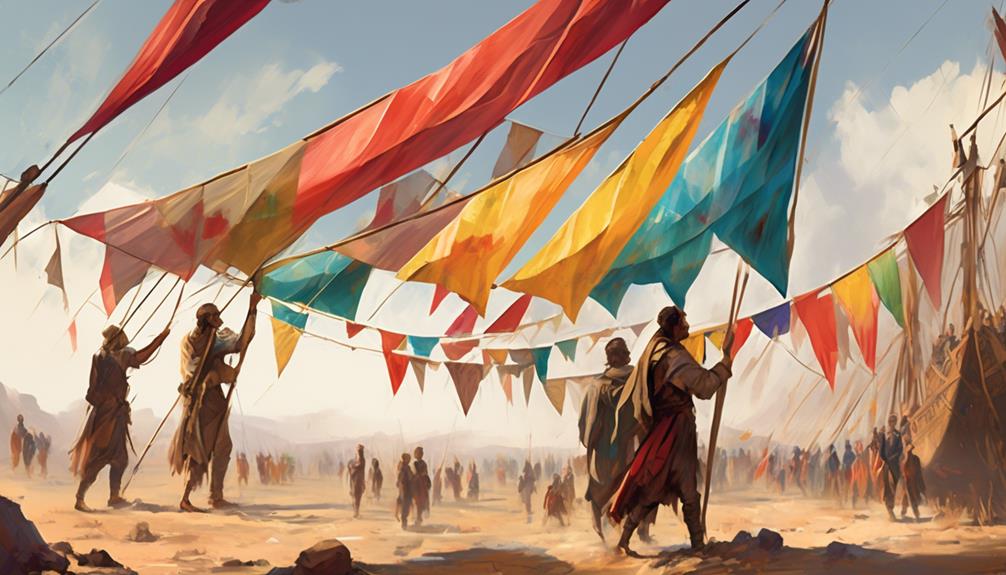
The origins of bunting can be traced back to ancient civilizations, where evidence of this decorative practice has been found in archaeological discoveries. The etymology of the word 'bunting' is thought to have originated from the Old French word 'bontin,' meaning 'colorful' or 'painted canvas.'
Historical origins suggest that bunting was initially used as a form of maritime flag communication, with colorful flags being used to send messages between ships. Over time, this practice extended to land-based celebrations and decorations, evolving into the festive bunting we recognize today.
In ancient times, bunting was made from various materials such as cotton, wool, and even silk, and was often adorned with intricate designs and patterns. The use of bunting as a decorative element became widespread during the 17th and 18th centuries, particularly in Europe and the United States, where it was used to embellish public spaces during festive occasions and celebrations.
Understanding the historical roots of bunting provides insight into its cultural significance and enduring appeal as a decorative art form.
Evolution of Bunting's Name
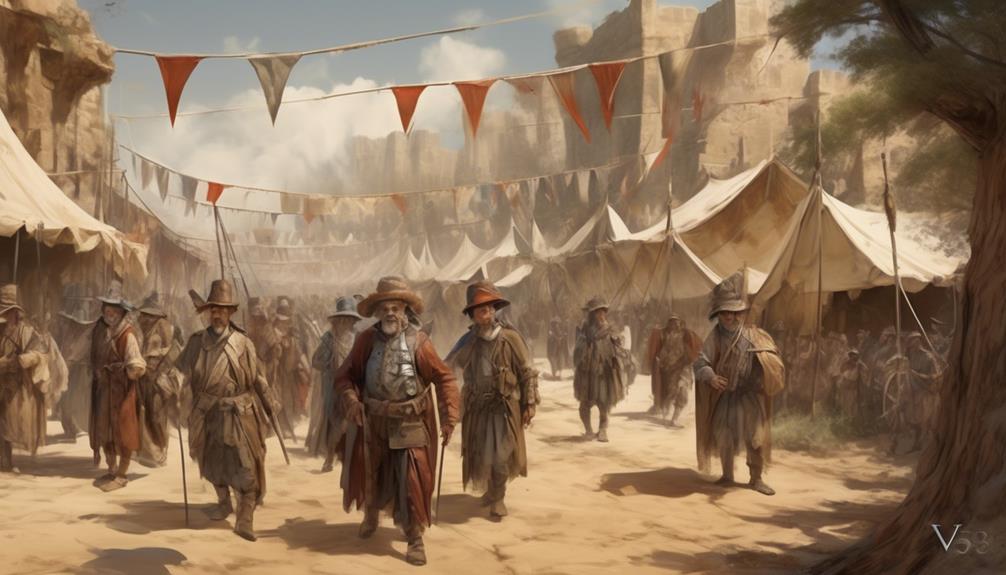
Tracing the etymology of the word 'bunting' leads us to the Old French term 'bontin,' which originally denoted 'colorful' or 'painted canvas,' providing insight into the evolution of bunting's name. Over time, the term 'bontin' transitioned into 'buntine' in Middle English, referring to a lightweight open fabric used for sieves or nets. This transformation reflects the evolving use of the material, shifting from decorative purposes to more functional applications.
As the English language continued to develop, 'buntine' gradually transformed into 'bunting,' expanding its meaning to encompass various types of loosely woven fabrics, particularly those used for flags and festive decorations. The semantic shift from a specific type of fabric to a broader category reflects the linguistic evolution of the term. This evolution demonstrates how language adapts to accommodate changes in material use and cultural practices.
Understanding the evolution of bunting's name provides valuable insights into the historical contexts in which the term was used and the cultural significance attached to it. Etymological analysis allows us to trace the trajectory of bunting's name, highlighting its journey from a colorful canvas to a diverse category of loosely woven fabrics.
Cultural Significance of Bunting
Exploring the cultural significance of bunting sheds light on its historical and symbolic resonance within various societal contexts. Bunting, with its origins as a maritime signal and festive decoration, has become deeply ingrained in traditional celebrations and symbolic decorations across the world. Its presence in cultural and historical events has made it an enduring symbol of unity, celebration, and national pride.
| Traditional Celebrations | Symbolic Decorations |
|---|---|
| Bunting is often used in traditional celebrations such as national holidays, weddings, and festivals, where it adorns streets, buildings, and parade floats, adding to the festive atmosphere. | As a symbolic decoration, bunting signifies unity, patriotism, and celebration. It is often used to represent national colors, bringing a sense of pride and identity to public spaces and events. |
This enduring tradition of using bunting for decorative and symbolic purposes has made it a beloved and recognizable feature in cultural celebrations. As societies continue to evolve, bunting remains a timeless emblem of joy and unity, connecting people across generations and cultures in moments of celebration and national pride.
Bunting in Different Languages
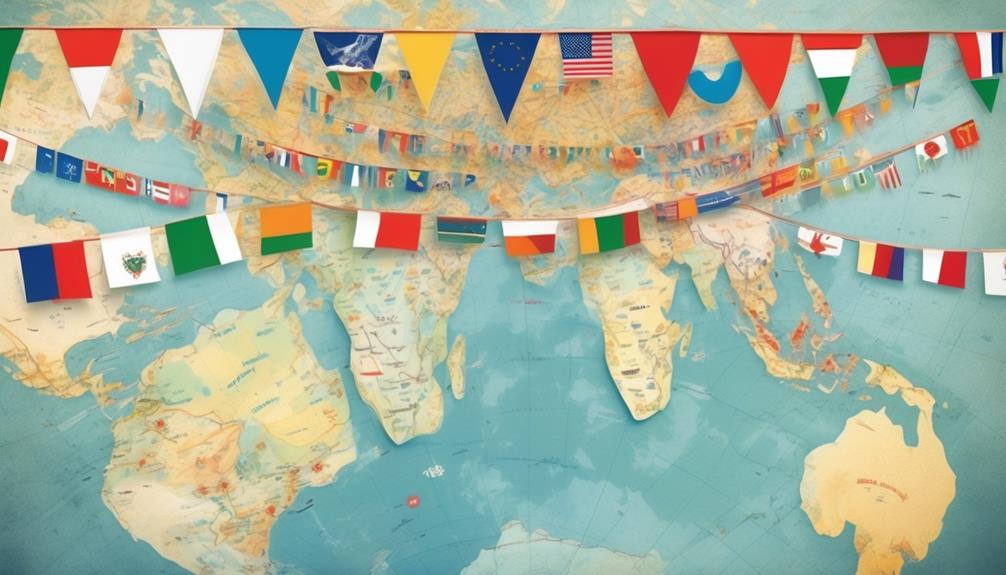
In understanding the cultural significance of bunting, it becomes apparent that its presence isn't confined to a single language, as its use and symbolism extend across various linguistic traditions.
Language variations in the use of bunting reveal its historical context and diverse cultural interpretations. In English, the term 'bunting' originally referred to the lightweight woolen cloth used for making flags, and its usage later extended to decorative flags and streamers.
In Spanish, 'banderines' or 'guirnaldas' are terms used for decorative bunting, reflecting the rich tradition of vibrant fiestas and celebrations in Hispanic cultures.
The French refer to bunting as 'fanions' or 'guirlandes,' reflecting their historical use in military and festive contexts.
German and Dutch languages use 'Wimpel' and 'vlaggetjes' respectively to denote bunting, reflecting the cultural significance of decorative flags in these societies.
These language variations highlight the historical context of bunting as a universal symbol of celebration, festivity, and cultural identity, transcending linguistic boundaries.
The Modern Appeal of Bunting
The modern appeal of bunting lies in its versatile use as a decorative element that adds a touch of nostalgia and whimsy to various events and settings. In today's context, bunting has found a place in modern aesthetics, offering a charming and elegant way to enhance the visual appeal of spaces. Its ability to evoke a sense of nostalgia while still feeling fresh and contemporary has contributed to its enduring popularity.
Creative applications of bunting have expanded its appeal, making it a staple in events ranging from intimate gatherings to large-scale festivals. Its ability to transform ordinary spaces into enchanting settings has made it a favorite among event planners and individuals alike. The creative use of colors, patterns, and materials has allowed bunting to adapt to a wide range of themes and styles, from rustic and vintage to modern and eclectic.
Moreover, its association with traditional celebrations and outdoor events has contributed to its modern appeal, as it brings a sense of warmth and conviviality to any setting. The enduring charm of bunting lies in its ability to infuse spaces with a sense of joy and celebration, making it a beloved decorative element in the contemporary world.
Frequently Asked Questions
What Are the Different Types of Materials Used to Make Bunting?
Types of materials used to make bunting include fabric, plastic, paper, and felt. These materials offer versatility for creative applications, such as outdoor decorations, party decor, and festive events.
Additionally, bunting materials can be repurposed for alternative uses, such as crafting and DIY projects. Each material brings unique qualities to bunting, allowing for diverse customization and visual appeal in various settings.
Is Bunting Only Used for Decorative Purposes, or Does It Have Other Practical Uses?
Practical uses of bunting extend beyond mere decoration. Its versatility makes it ideal for creative applications. Although often associated with festive occasions, bunting has practical uses in maritime signaling, aviation, and even military contexts.
Its vibrant colors and eye-catching design also make it a valuable tool for advertising and safety markings. The historical evolution of bunting's practical applications showcases its enduring significance in various fields.
Are There Any Specific Traditions or Customs Associated With the Use of Bunting in Different Cultures?
In different cultures, bunting carries significant cultural significance and is often intertwined with historical origins. Various traditions and customs are associated with its use, reflecting the diverse ways it's utilized for celebrations and events.
The historical origins of bunting reveal its evolution and continued relevance in different cultural contexts, shedding light on its enduring importance. Understanding these traditions and historical connections provides insight into the rich tapestry of meanings associated with bunting.
How Has the Popularity of Bunting Changed Over Time?
The evolution of bunting's popularity has been fascinating. Over time, it has transitioned from a traditional decorative element to a symbol of celebration and festivity.
The cultural significance of bunting has grown, becoming a ubiquitous feature at events and gatherings. Its colorful and cheerful nature has made it a beloved adornment, reflecting the joyous spirit of various occasions.
This shift in perception has contributed to the enduring appeal of bunting across different cultures.
Are There Any Superstitions or Beliefs Surrounding the Use of Bunting in Certain Cultures?
Superstitions and cultural significance surrounding bunting vary widely across different cultures. In some societies, bunting is believed to bring good luck and ward off evil spirits when displayed during celebrations and festivals.
Conversely, in other traditions, there are superstitions associated with the colors and patterns of bunting, with specific combinations believed to attract prosperity or protect against misfortune.
Understanding these beliefs adds depth to the history and use of bunting in diverse cultures.
Is There a Cultural Significance Behind the Name “Bunting” and the Tradition of Cake Smashing?
The tradition of cake smashing has become a popular trend in recent years, with many couples incorporating it into their wedding festivities. While the reasons for cake smashing vary, it is often seen as a fun and lighthearted way to celebrate the joy of marriage. As for the cultural significance behind the name “Bunting”, it is often associated with festive and celebratory occasions, making it a fitting choice for a wedding tradition like cake smashing.
Conclusion
In tracing the origins of bunting and its name, we've uncovered a rich history of cultural significance and evolution. From its humble beginnings to its modern appeal, bunting has woven itself into the fabric of our lives.
Its colorful presence brings joy and celebration, like a fluttering array of flags in the wind, symbolizing unity and festivity across different cultures and languages.
The name 'bunting' may have a simple origin, but its impact is profound and enduring.
- About the Author
- Latest Posts
Introducing Ron, the home decor aficionado at ByRetreat, whose passion for creating beautiful and inviting spaces is at the heart of his work. With his deep knowledge of home decor and his innate sense of style, Ron brings a wealth of expertise and a keen eye for detail to the ByRetreat team.
Ron’s love for home decor goes beyond aesthetics; he understands that our surroundings play a significant role in our overall well-being and productivity. With this in mind, Ron is dedicated to transforming remote workspaces into havens of comfort, functionality, and beauty.
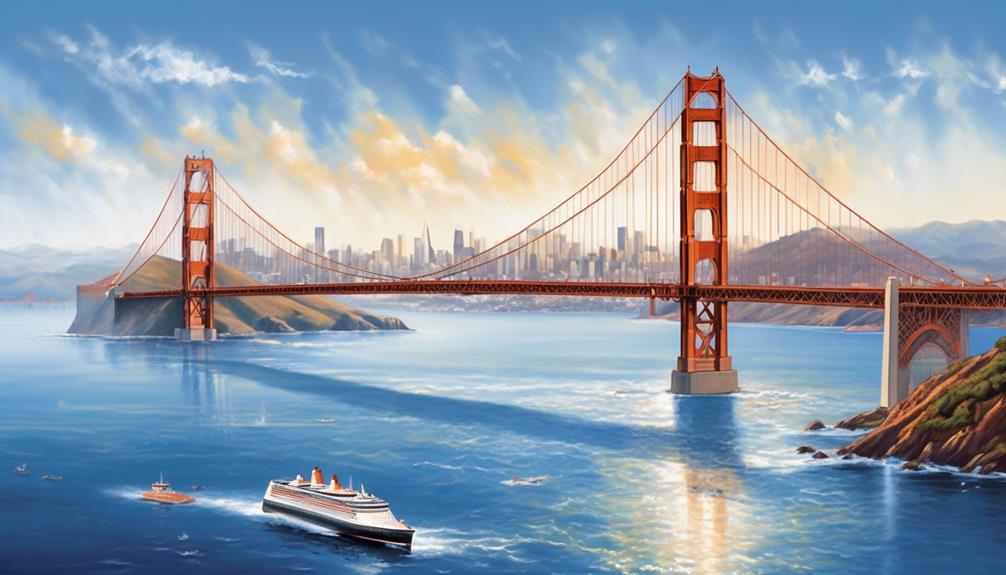
As we explore the numerous cruise choices leaving from San Francisco, it is interesting to observe that the city’s cruise terminal experienced a 9% rise in passenger traffic last year. With a wide variety of destinations and experiences available, it is no surprise that San Francisco has become a vibrant center for cruise enthusiasts.
But before we set sail into the details of the best cruises from this iconic port, let's take a moment to consider the unique allure of embarking on a voyage from the City by the Bay.
Key Takeaways
- San Francisco cruise terminal experienced a 9% increase in passenger traffic last year.
- The Alaskan adventure cruise offers wildlife encounters and glacial exploration.
- The Hawaiian Paradise cruise offers island-hopping delights and diverse Hawaiian cuisine.
- The Mexican Riviera cruise offers sun, sand, Mexican cuisine, and captivating cultural experiences.
Alaskan Adventure: Discover the Wild North
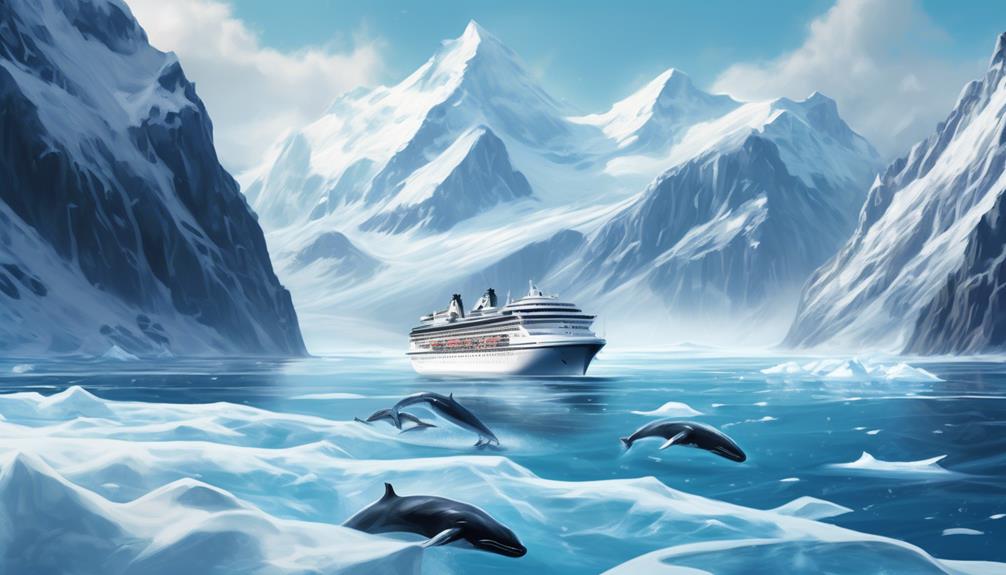
Embark on an unforgettable Alaskan adventure and discover the untamed beauty of the Wild North with our exhilarating cruise from San Francisco. As you set sail, be prepared for awe-inspiring wildlife encounters.
The crisp, salty air fills your lungs as you scan the horizon for a glimpse of a breaching humpback whale or a majestic bald eagle soaring overhead. The pristine waters teem with life, offering a chance to witness playful otters and curious seals as they navigate their natural habitat.
Glacial exploration is a cornerstone of our Alaskan adventure. Feel the chill in the air as you approach these ancient rivers of ice. Towering glaciers command attention with their breathtaking beauty and raw power. Witness the spectacle of massive ice calving into the sea, creating a thunderous roar that reverberates through the fjords. Our expert guides provide captivating insights into the geological forces that have shaped this unique landscape over millennia.
With wildlife encounters and glacial exploration awaiting at every turn, our Alaskan adventure promises an enriching and unforgettable experience.
Pacific Coast Escapade: Scenic Coastal Cruises

Meandering along the Pacific Coast, our scenic coastal cruises offer a captivating blend of breathtaking vistas and tranquil seascapes, inviting you to immerse yourself in the natural beauty of the West Coast.
As we sail along this stunning coastline, passengers are treated to unparalleled scenic views of rugged cliffs, pristine beaches, and charming coastal towns. The relaxing atmosphere on board complements the serene surroundings, allowing guests to unwind and fully appreciate the awe-inspiring sights.
From the comfort of the ship, passengers can witness the dramatic beauty of the Pacific Coast unfold before their eyes. The ever-changing scenery, from majestic rock formations to lush forests meeting the sea, creates a picturesque backdrop for a truly unforgettable journey. Our expert crew is dedicated to ensuring that every guest has the opportunity to savor these remarkable views, whether from spacious deck areas or through panoramic windows in the ship's common areas.
With an emphasis on providing an enriching and rejuvenating experience, our scenic coastal cruises are designed for those seeking a deeper connection with nature and a profound appreciation for the wonders of the Pacific Coast. Whether you're a seasoned traveler or embarking on your first cruise, our Pacific Coast escapade promises an unparalleled blend of relaxation and natural beauty.
Hawaiian Paradise: Island-Hopping Delights
As we set sail for the Hawaiian Paradise, prepare to be captivated by the allure of island-hopping delights that await us in the tranquil waters of the Pacific. Our journey through the Hawaiian Islands promises an enchanting blend of tropical beaches and vibrant culture. From the moment we arrive at the first island, the air is filled with the scent of plumeria and the sound of ukuleles, beckoning us to immerse ourselves in the local rhythm.
Each island offers its own unique charm, from the stunning volcanic landscapes of the Big Island to the lush rainforests of Kauai.
Our adventure will take us to Maui, where we can bask in the beauty of the famous Road to Hana, and to Oahu, where we can explore the historic sites of Honolulu and surf the legendary waves of the North Shore. The island-hopping experience allows us to sample the diverse flavors of Hawaiian cuisine, from traditional luau feasts to innovative farm-to-table dining experiences.
With its rich history, breathtaking natural wonders, and warm hospitality, the Hawaiian Paradise is a destination that promises an unforgettable journey through some of the most beautiful islands in the world.
Mexican Riviera Exploration: Sun, Sand, and Culture
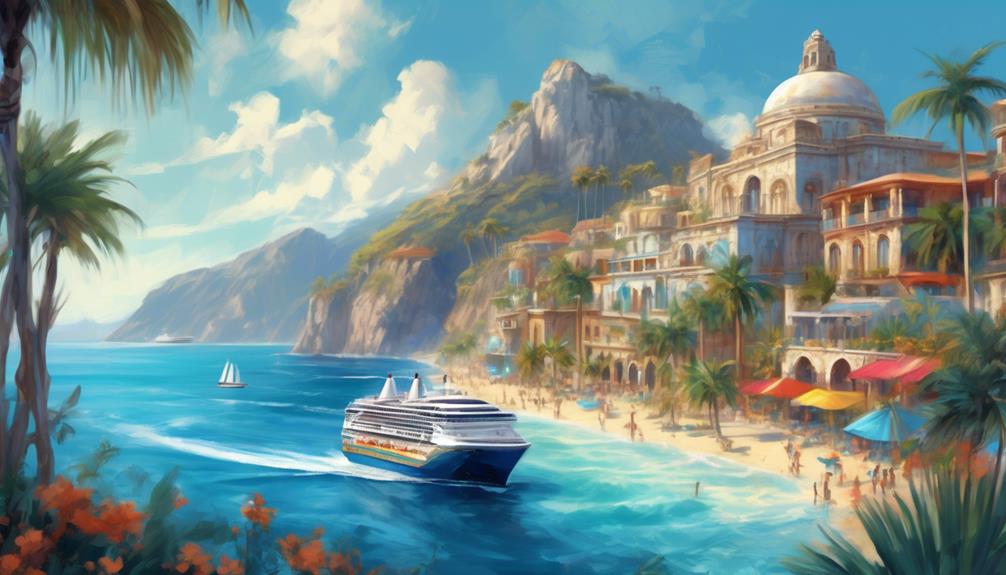
Exploring the Hawaiian Paradise has been an unforgettable journey, and now we're thrilled to set our sights on the vibrant Mexican Riviera, where sun, sand, and culture await us for an enriching exploration.
The Mexican Riviera is a treasure trove of experiences, offering breathtaking beach activities, a rich tapestry of local cuisine, traditional dances, and fascinating historical sites.
As we step onto the soft, golden sands, we'll be greeted by the rhythmic beats of traditional music and the aroma of delectable, authentic Mexican dishes. The beaches here are perfect for diving into thrilling water sports or simply lounging under the warm, tropical sun.
Our taste buds will be tantalized by the flavors of freshly caught seafood, zesty salsas, and mouthwatering tacos. Moreover, the Mexican Riviera's captivating culture comes alive through vibrant traditional dances and the opportunity to explore historical sites like the ancient Mayan ruins.
This journey promises to be an immersive experience, where every moment is filled with the colors, flavors, and rhythms of this captivating region.
Transpacific Voyages: Epic Ocean Crossings
Embarking on transpacific voyages offers a thrilling opportunity to experience epic ocean crossings that traverse vast expanses of open water, connecting diverse and captivating destinations. As we prepare to set sail on these extraordinary maritime adventures, we're filled with anticipation for the historical significance and cultural exchange that awaits us.
Here's why transpacific voyages are a must for those seeking international exploration:
- Historical Significance: These voyages trace the routes of ancient explorers, connecting the Pacific Rim and playing a pivotal role in shaping world history.
- Maritime Adventures: From the moment we embark, we're immersed in the legacy of seafaring, experiencing the thrill of navigating the open sea while learning about the rich maritime heritage.
- Cultural Exchange: As we cross the vast Pacific, we anticipate the opportunity to engage with diverse cultures, languages, and traditions, fostering a deep appreciation for global diversity.
- International Exploration: Transpacific voyages open the door to a world of exploration, offering access to remote islands, bustling metropolises, and everything in between, making it an unforgettable journey of discovery.
Prepare to be captivated by the allure of transpacific voyages, where the call of adventure meets the embrace of international discovery.
Frequently Asked Questions
What Are the Onboard Entertainment Options for Families With Young Children on These Cruises?
We offer various onboard entertainment options for families with young children, including childcare facilities and kids clubs. These spaces are designed to provide a safe and engaging environment for kids to have fun while parents enjoy other activities.
Additionally, we offer a wide range of entertainment and activities suitable for all ages, ensuring that the whole family can enjoy their time on the cruise.
Are There Any Special Dining Options or Culinary Experiences Available on These Cruises?
We love the culinary workshops and specialty restaurants on these cruises.
The culinary workshops offer a hands-on experience, teaching us new cooking techniques and recipes.
The specialty restaurants provide a diverse array of gourmet dining options, from fine dining to international cuisines.
It's a delightful way to explore different flavors and indulge in unique culinary experiences while sailing the seas.
What Are the Vaccination and Health Requirements for Passengers on These Cruises?
Vaccination requirements and health screenings are essential for passengers on these cruises. It's crucial to ensure all travelers are up to date with their vaccinations and pass health screenings before boarding.
Additionally, having travel insurance is wise, and knowing the availability of medical facilities on the cruise is important for peace of mind.
These measures contribute to a safe and enjoyable experience for everyone on board.
Can Passengers Bring Their Own Alcohol on Board or Is It Available for Purchase?
Yes, passengers are responsible for adhering to the alcohol policy. Most cruises offer the option to purchase alcohol onboard. However, bringing one's own alcohol is generally not allowed due to safety and security reasons.
The onboard facilities usually include bars and lounges where passengers can purchase a variety of alcoholic beverages. It's important to check with the specific cruise line for their purchasing options and policies regarding alcohol consumption.
Are There Any Specific Packing Tips or Dress Code Recommendations for These Cruises?
When it comes to packing for cruises, it's essential to consider the destination and activities. For warm destinations, lightweight clothing, bathing suits, and sunscreen are must-haves.
For cooler climates, layers and a waterproof jacket are essential.
As for dress codes, most cruises have formal nights, so packing a cocktail dress or suit is a good idea. Check the specific cruise line's guidelines to ensure you're prepared for all occasions.
Are There Any Cruises From San Francisco That Cater to 18 Year Olds?
Yes, there are best cruise options for teens from San Francisco. Many cruise lines offer sailings that cater to 18-year-olds with activities, entertainment, and excursions suitable for young adults. From adventurous activities to vibrant nightlife, these cruises provide a great mix of fun for 18-year-olds.
Conclusion
We hope you've enjoyed learning about the best cruises from San Francisco.
Did you know that the Port of San Francisco saw a 10% increase in cruise ship passengers in 2019?
With so many incredible destinations to choose from, there's no better time to set sail from the City by the Bay and embark on an unforgettable adventure at sea.
Happy cruising!
- About the Author
- Latest Posts
Introducing Ron, the home decor aficionado at ByRetreat, whose passion for creating beautiful and inviting spaces is at the heart of his work. With his deep knowledge of home decor and his innate sense of style, Ron brings a wealth of expertise and a keen eye for detail to the ByRetreat team.
Ron’s love for home decor goes beyond aesthetics; he understands that our surroundings play a significant role in our overall well-being and productivity. With this in mind, Ron is dedicated to transforming remote workspaces into havens of comfort, functionality, and beauty.

When it comes to flying, the experience can greatly differ depending on various factors. One thing that can definitely impact the journey is the selection of beverages offered on the plane.
Whether you're a seasoned traveler or a first-time flyer, knowing the best drinks to order on a plane can enhance your in-flight experience. From classic cocktails to specialty in-flight creations, the options can be surprisingly diverse. But how do you know which ones to choose?
We'll explore a range of beverage choices that can elevate your time in the air and leave you feeling refreshed upon arrival.
Key Takeaways
- The Old Fashioned is a popular choice among travelers and remains a steadfast favorite on planes.
- Wine selections such as Chateau Montelena Chardonnay, Domaine Serene Pinot Noir, and Veuve Clicquot Champagne offer diverse options to enhance in-flight meals.
- Craft brews and local options, including IPA, Stout or Porter, and Wheat Beer, elevate the beer experience with regional flavors.
- Offering a diverse selection of non-alcoholic beverages, including fruit juices, soft drinks, and bottled water, caters to passengers' preferences and keeps them hydrated during the flight.
Classic Cocktails
When we board a plane, our go-to classic cocktail is often the timeless and sophisticated Old Fashioned. This iconic drink has stood the test of time and continues to be a favorite for many travelers. The mixology secrets behind a perfect Old Fashioned lie in the careful balance of bourbon or rye whiskey, a sugar cube, aromatic bitters, and a twist of orange zest.
Craft cocktail trends may come and go, but the Old Fashioned remains a steadfast choice for those seeking a refined and timeless drink.
As mixology continues to evolve, classic cocktails like the Old Fashioned have seen a resurgence in popularity. Bartenders are rediscovering the art of crafting these traditional drinks, often incorporating small tweaks to elevate the flavors. Whether it's using a particular type of bitters or experimenting with different types of sugars, there's a renewed appreciation for the nuances of classic cocktail recipes.
The next time we find ourselves on a plane, we can confidently order an Old Fashioned, knowing that we're sipping on a drink that embodies mixology secrets and reflects the enduring charm of craft cocktail trends.
Wine Selections
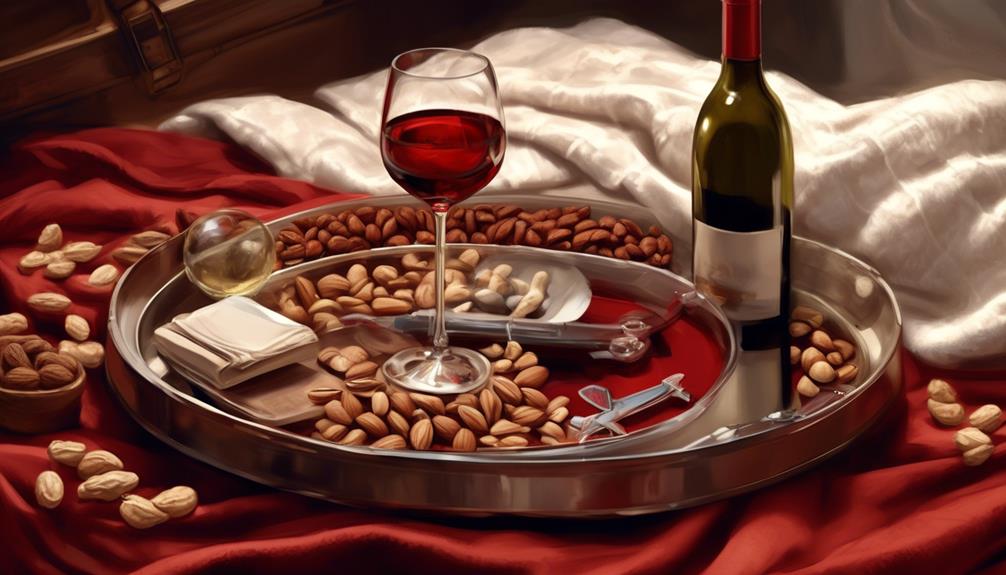
As we explore the wine selections, our journey from classic cocktails like the Old Fashioned leads us to a new realm of delightful and diverse flavors awaiting discovery. When it comes to wine pairings, knowing the vineyard selections can elevate the in-flight experience. Here are some recommended vineyard selections to savor on your next flight:
| Vineyard | Wine | Pairing Suggestions |
|---|---|---|
| Chateau Montelena | Chardonnay | Pair with chicken or pasta dishes. |
| Domaine Serene | Pinot Noir | Perfect with salmon or mushroom-based dishes. |
| Veuve Clicquot | Champagne | Complements salty snacks or seafood. |
These vineyard selections offer a range of flavors to enhance your in-flight meal. From the rich and buttery notes of Chateau Montelena's Chardonnay to the elegant and aromatic Domaine Serene Pinot Noir, there is a wine to suit every palate. And for those looking to add a touch of luxury to their journey, Veuve Clicquot Champagne is an excellent choice, with its crisp effervescence and versatility in pairing with various in-flight snacks. So, sit back, relax, and enjoy the exquisite vineyard selections as you soar through the sky.
Beer and Ale Options
Let's explore the enticing array of beer and ale options available for an enjoyable in-flight experience. When it comes to beer, craft brews and local options can elevate your taste buds while cruising at 30,000 feet. Here are three top picks to consider:
- IPA (India Pale Ale): Known for its bold hop flavor and higher alcohol content, IPAs are a popular choice among beer enthusiasts. Look for local breweries offering their take on this classic style, providing a unique and flavorful experience.
- Stout or Porter: If you prefer a darker, richer brew, stouts and porters are excellent choices. These beers often have notes of coffee, chocolate, or caramel, making them a delightful option for sipping during a flight.
- Wheat Beer: For a lighter and more refreshing option, consider a wheat beer. Brewed with a significant proportion of wheat, this style often offers a crisp and slightly fruity taste, perfect for quenching your thirst while in the air.
Craft brews and local options are fantastic ways to explore the regional beer scene, even when you're thousands of feet above the ground. Cheers to a great in-flight beer selection!
Non-Alcoholic Beverages

We always make sure to offer a diverse selection of non-alcoholic beverages for our passengers to enjoy during their flight.
Staying refreshed and hydrated is essential, so we provide a range of options to cater to different preferences.
For those seeking refreshing options, we offer a variety of fruit juices, including orange, apple, and cranberry, to quench your thirst.
Additionally, our assortment of soft drinks, such as cola, lemon-lime soda, and ginger ale, provides fizzy and flavorful hydration choices.
We also understand the importance of staying healthy while traveling, which is why we offer bottled water and sparkling water to keep you feeling revitalized throughout your journey.
Our goal is to ensure that every passenger has access to their preferred non-alcoholic beverage, whether it's a classic choice or something new to discover.
Specialty In-Flight Creations
Keeping our passengers' refreshment in mind, we also offer a selection of specialty in-flight creations to elevate their travel experience. Our aim is to provide an exceptional and diverse range of beverages that cater to every taste.
Here are three of our most sought-after specialty in-flight creations:
- Signature Mocktails: Our expert mixologists have crafted a selection of refreshing and alcohol-free mocktails that are designed to tantalize the taste buds. From zesty citrus blends to fruit-infused fusions, our signature mocktails offer a delightful alternative for passengers who prefer non-alcoholic options.
- Unique Coffee Blends: We understand the importance of a good cup of coffee, especially during long flights. That's why we take pride in offering unique coffee blends that are specially curated for the in-flight experience. Whether you prefer a rich and bold espresso or a smooth and creamy latte, our specialty coffee blends are sure to satisfy the most discerning coffee connoisseurs.
- Custom Infusions: To cater to the evolving preferences of our passengers, we also offer custom infusions that combine fresh ingredients with innovative flavors. From herbal tea infusions to artisanal fruit-infused water, our custom creations are perfect for those seeking a distinctive and memorable in-flight beverage experience.
Frequently Asked Questions
Can I Bring My Own Alcohol on the Plane?
Sure, you can bring your own alcohol on the plane, but there are some regulations to consider.
Airport security has specific rules about the amount and type of alcohol you can bring.
Also, keep in mind that you may not be allowed to mix your own drinks on the plane, so it's best to check with the airline beforehand.
It's always a good idea to review the regulations before packing any beverages for your flight.
Are There Any Special Cocktail Options for Passengers With Dietary Restrictions or Preferences?
When it comes to special cocktail options for passengers with dietary restrictions or preferences, mocktail alternatives can be a great choice. These delicious non-alcoholic options cater to a variety of tastes and dietary needs, making them a fantastic option for those looking for a unique and refreshing drink while on a flight.
Whether it's a specific dietary requirement or a personal preference, mocktails offer a tasty and satisfying alternative to traditional cocktails.
Do Airlines Offer Any Local or Regional Beer Options?
Local brews and regional favorites are often available on flights, offering a taste of the destination. Craft beer options vary by airline, and some may even allow bringing alcohol onboard.
For those with dietary restrictions, airlines may offer dietary-friendly cocktails, mocktail options, and the ability to make custom drink requests to suit personal preferences.
It's a great way to enjoy a taste of the local scene while flying.
Are There Any Non-Alcoholic Mocktail Options Available on the Flight?
When it comes to non-alcoholic mocktail options on the flight, there are usually a variety of refreshing choices available.
Airlines often provide a range of non-alcoholic beverage alternatives, including mocktails crafted with fresh fruit juices and flavorful syrups.
These creative and alcohol-free concoctions are perfect for those looking to enjoy a delicious and unique drink while soaring through the skies.
Can Passengers Request a Custom In-Flight Creation Based on Their Personal Preferences?
Absolutely, passengers can request a custom in-flight creation based on their personal preferences. This in-flight mixology experience allows us to craft a unique drink tailored to your tastes.
Whether it's a refreshing mocktail or a classic cocktail, we're here to elevate your flying experience. Just let us know your preferences, and we'll work our magic to create the perfect custom drink for you.
Cheers to personalized inflight beverages!
What are the Best Drinks to Order on a Family-Friendly Cruise?
When it comes to the best family friendly cruises, it’s important to consider the drink options available. Non-alcoholic choices like mocktails, smoothies, and fresh juices are always a hit with kids and adults alike. Some cruise lines even offer special kids’ drink menus with fun and colorful options.
Conclusion
So next time you're flying, be sure to order one of these amazing drinks. Whether it's a classic cocktail, a fine wine, a craft beer, or a refreshing non-alcoholic beverage, we've got you covered.
And don't forget to try one of the specialty in-flight creations for a truly unique experience. With these options, you'll feel like you're sipping on luxury at 30,000 feet.
Cheers to a smooth and enjoyable flight!
- About the Author
- Latest Posts
Introducing Ron, the home decor aficionado at ByRetreat, whose passion for creating beautiful and inviting spaces is at the heart of his work. With his deep knowledge of home decor and his innate sense of style, Ron brings a wealth of expertise and a keen eye for detail to the ByRetreat team.
Ron’s love for home decor goes beyond aesthetics; he understands that our surroundings play a significant role in our overall well-being and productivity. With this in mind, Ron is dedicated to transforming remote workspaces into havens of comfort, functionality, and beauty.
-

 Decor3 days ago
Decor3 days agoMaximalist Decor Explained: Embrace More Style
-

 Vetted3 weeks ago
Vetted3 weeks ago15 Best Drip Irrigation Systems to Keep Your Garden Thriving
-

 Vetted1 week ago
Vetted1 week ago15 Best Foot Massagers for Neuropathy to Soothe Your Feet and Relieve Discomfort
-

 Vetted2 weeks ago
Vetted2 weeks ago15 Best Sports Laundry Detergents for Keeping Your Activewear Fresh and Clean
-

 Vetted2 weeks ago
Vetted2 weeks ago15 Best Tall Toilets for Seniors That Combine Comfort and Safety
-

 Vetted3 weeks ago
Vetted3 weeks ago15 Best Dish Scrubbers to Keep Your Kitchen Sparkling Clean
-

 Decor3 weeks ago
Decor3 weeks agoWhat Is Eclectic Home Decor
-

 Decor1 week ago
Decor1 week agoWhere the Wild Things Are Nursery Decor




















